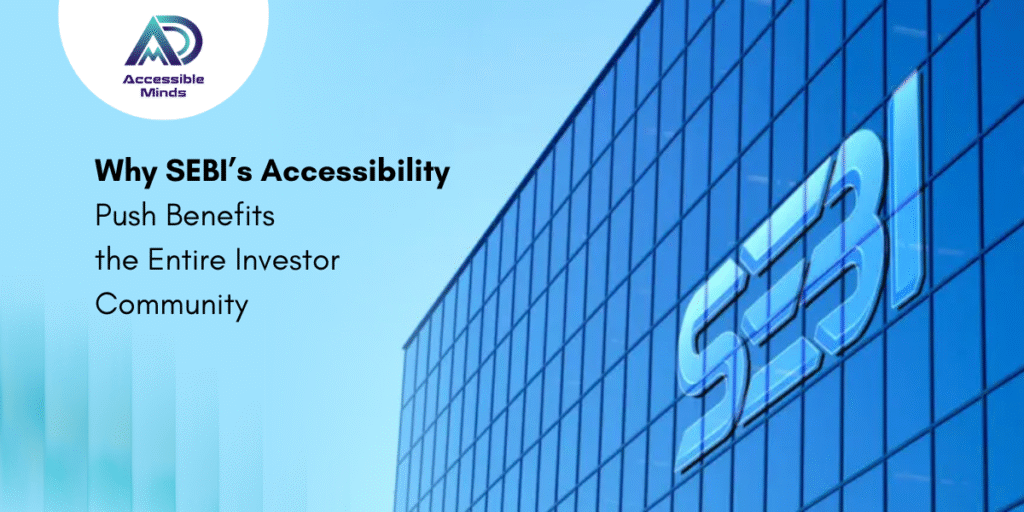On July 31, 2025, the Securities and Exchange Board of India (SEBI) took a historic step toward making India’s financial ecosystem more inclusive by releasing Circular No. SEBI/HO/ITD-1/ITD_VIAP/P/CIR/2025/111 — a directive that mandates digital accessibility for all SEBI-regulated entities. This SEBI Digital Accessibility Circular has officially transformed accessibility from a “good-to-have” into a regulatory obligation.
A follow-up circular, SEBI/HO/ITD-1/ITD_VIAP/P/CIR/2025/121, released on August 29, 2025, extended certain timelines for Investment Advisers (IAs) and Research Analysts (RAs) and clarified their reporting structure. Together, these directives form the backbone of the SEBI Mandate for Digital Accessibility, reshaping how financial institutions design and deliver digital services in India.
Understanding the SEBI Digital Accessibility Mandate
The SEBI Digital Accessibility Mandate requires all regulated entities (REs) — including stock exchanges, brokers, depositories, mutual funds, investment advisers, portfolio managers, and credit rating agencies — to make their digital platforms accessible to persons with disabilities (PwDs).
This applies to websites, mobile apps, investor portals, trading platforms, market disclosures, and all digital documents or multimedia content. In essence, if your organization provides any investor-facing digital service, it must now be usable by everyone — including individuals with visual, auditory, cognitive, or motor impairments.
Key Compliance Requirements
To meet the SEBI Mandate for Digital Accessibility, all entities must align with global and national standards such as:
- WCAG 2.1 Level AA (or latest version)
- GIGW Guidelines (Government of India Web Guidelines)
- IS 17802, India’s digital accessibility standard
- Rights of Persons with Disabilities (RPwD) Act, 2016
SEBI’s circular outlines clear operational requirements, including:
- Appointing a senior nodal officer responsible for accessibility compliance.
- Conducting periodic accessibility audits by IAAP-certified professionals.
- Maintaining Accessibility Conformance Reports (ACRs) or VPATs.
- Establishing grievance redressal mechanisms for accessibility-related issues.
- Ensuring third-party vendors and technology tools are accessible by design.
Content and User Interface Requirements
Accessibility goes beyond just websites — it’s about every digital interaction an investor has. The circular emphasizes that:
- Documents (PDF, Word, Excel) must be properly tagged and formatted for screen readers.
- Videos and webcasts should include captions, transcripts, and where possible, Indian Sign Language (ISL) support.
- Images, infographics, and charts must include descriptive alternative text.
- User interfaces should support keyboard navigation, semantic markup, and assistive technologies.
Reporting and Compliance Timelines
SEBI’s circular introduces structured reporting obligations and timelines. Entities must submit compliance reports, digital platform lists, and audit confirmations within specified timeframes.
Key milestones include:
- Appoint IAAP-certified auditors: within 45 days (by Dec 14, 2025).
- Complete initial accessibility audits: within 3 months (by April 30, 2026).
- Remediate audit findings: within 6 months (by July 31, 2026).
- Conduct annual audits and submit compliance confirmations each financial year.
Additionally, reporting authorities differ by category:
- Stock Brokers/Depositories: Report to respective Stock Exchanges/Depositories.
- IAs & RAs: Report to BSE Ltd.
- Other regulated entities (REs): Report directly to SEBI.
Why This Matters — Beyond Compliance
The SEBI Digital Accessibility Mandate isn’t just about legal compliance; it’s a step toward financial inclusion. For millions of investors with disabilities, digital barriers often mean exclusion from essential financial services. By enforcing accessibility, SEBI ensures equal opportunity for participation in India’s capital markets.
Globally, regulators in the US, UK, EU, and Australia already enforce similar standards. SEBI’s move brings India in line with these global best practices, signaling a shift toward inclusive digital governance.
For businesses, this mandate represents more than a compliance checklist — it’s an opportunity to enhance user experience, expand audience reach, and strengthen trust.
How Accessibility Benefits the Investor Community
Accessibility improves usability for everyone, not just those with disabilities. When platforms adhere to accessibility standards:
- Older adults and those with age-related impairments navigate with ease.
- Investors on slow networks or small screens experience smoother usability.
- Screen reader and voice navigation users gain full access to financial tools and disclosures.
The result? A more inclusive, efficient, and transparent digital ecosystem — one where every investor can participate equally.
The Business Case for Web Accessibility Services
Many organizations are turning to professional Web Accessibility Services to meet SEBI’s expectations effectively. These services offer:
- Comprehensive accessibility audits aligned with WCAG and IS 17802 standards.
- Remediation support for websites, apps, and documents.
- Training programs for developers, designers, and content creators.
- Ongoing monitoring to maintain compliance across product updates.
Partnering with certified accessibility experts not only ensures adherence to the SEBI Digital Accessibility Circular but also helps companies future-proof their platforms against evolving global standards.
Risks of Non-Compliance
Ignoring the SEBI mandate could have serious repercussions:
- Regulatory penalties or warnings from SEBI.
- Reputation damage and loss of investor trust.
- Accessibility-related legal actions under the RPwD Act.
- Customer attrition, as users migrate to more accessible competitors.
Accessibility issues don’t just impact compliance — they affect business credibility, inclusivity, and customer satisfaction.
Next Steps for SEBI-Regulated Entities
To comply with the SEBI Mandate for Digital Accessibility, organizations should:
- Audit all digital platforms (websites, apps, portals, trading systems).
- Prioritize remediation of critical accessibility barriers.
- Train internal teams in accessibility best practices.
- Integrate accessibility into development and procurement processes.
- Document compliance with VPATs and ACRs.
This proactive approach ensures not only regulatory alignment but also long-term inclusivity and trust in your digital platforms.
Final Thoughts
SEBI’s accessibility directive is more than a policy — it’s a statement of intent. It acknowledges that accessibility is a fundamental right and a strategic advantage in today’s digital-first world.
By embracing the SEBI Digital Accessibility Mandate, organizations demonstrate leadership, empathy, and innovation — qualities that today’s investors value deeply.
Accessibility isn’t charity.
It’s smart design, responsible governance, and now, the law.
The time to act is now — because inclusion benefits everyone.

